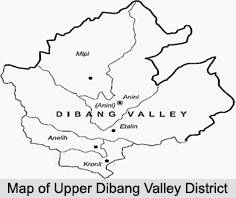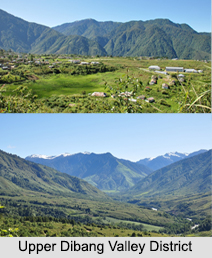 With undulated-rugged mountains and breath-taking green valleys, deep gorges, enchanting waterfalls and natural lakes, the Upper Dibang Valley District is one of the largest districts of Arunachal Pradesh. The valley district has been named after the Dibang River or the Talons as the tribal group of Mishims call it.
With undulated-rugged mountains and breath-taking green valleys, deep gorges, enchanting waterfalls and natural lakes, the Upper Dibang Valley District is one of the largest districts of Arunachal Pradesh. The valley district has been named after the Dibang River or the Talons as the tribal group of Mishims call it.
History of Upper Dibang Valley District
Prior to June 1980, the Upper Dibang Valley District was a part of the Lohit District and on December 16th, 2001 the Dibang Valley district was bifurcated into Upper Dibang Valley district and Lower Dibang Valley district.
Geography of Upper Dibang Valley District
Spreading over a total area of 9, 129 sq. km and known to be one of the largest districts of Arunachal Pradesh, the Upper Dibang Valley District contains the northernmost point of the Northeast India. The Dibang River originates in the Tibetan mountains and flows through the length of the Upper Dibang Valley District. The capital of the district is Anini, which is the northernmost district capital in north east India.
 There is only one Arunachal Pradesh Legislative Assembly constituency in this district which is Anini and is part of the Arunachal East Lok Sabha constituency.
There is only one Arunachal Pradesh Legislative Assembly constituency in this district which is Anini and is part of the Arunachal East Lok Sabha constituency.
Demographics of Upper Dibang Valley District
As per the reports of Census India 2011, the total population of the district is 7, 948 and is the most sparsely populated district in the country. The Upper Dibang Valley District has a population density of 0.8 inhabitants per sq. km. The population growth over the decade of 2001 to 2011 has been 9.3 percent and has a sex ratio of 808 females for every 1000 males. The literacy rate of the Upper Dibang Valley District is 64.8 percent and the major population of this district mainly consist of the Mishmis. The majority religion here is Hinduism consisting of about 50 percent of the total population.
The languages spoken here in this Upper Dibang Valley District include Mishmi, a Sino-Tibetan tongue with approximately 25000 speakers, written in both the Tibetan and Latin scripts.
Wildlife of Upper Dibang Valley District
The Upper Dibang Valley District is rich in flora and fauna with rare mammals such as Mishmi takin, Red goral and Gongshan muntjac and rare birds like the Sclater`s Monal. The flying squirrel has been recently discovered from this district and has been named as Mishmi Hills Giant Flying Squirrel. In 1991, the Upper Dibang Valley District became home to the Dibang Wildlife Sanctuary, which has an area of 4,149 sq. km.






